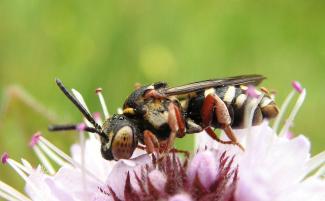
Image Credit: Nigel Jones
Large Cuckoo-Bees: Apidae: (Doeringiella, Epeolus)
These bees are very distinctive and cannot be confused with other bees. Epeolus parasitizes silk-lining bees (Colletes) and Doeringiella (formerly known as Triepeolus) parasitizes long-horned bees (Eucerini). They are actually rare, but their large size and prominent pattern results in many observations. The Northwestern species have never been adequately studied.
Bees that nest gregariously often suffer severely from parasitization by cuckoo-bees. Multi-year studies of nesting sites often document quickly increasing parasite populations. Though one would think that nesting females would assist neighbors in driving cuckoo-bees away from gregarious nests, I have never observed them to do so. They will attack a parasite in their own nest, but not show the same care for a neighbor.
The unique genus Epeoloides is a nest parasite of the oil-collecting bee, Macropis. It has never been collected in the Pacific Northwest, but any discovery of populations of Macropis should be carefully observed for the presence of this extremely rare bee. It has nearly black wings and a shiny abdomen without hair bands that varies from all black to all red. If discovered, a local entomologist should be notified.


Kleptoparasites of Colletes, the genus Epeolus.


Kleptoparasites of the tribe Eucerini, the genus Doeringiella (often called Triepeolus).